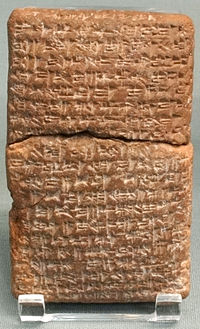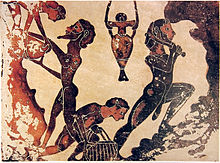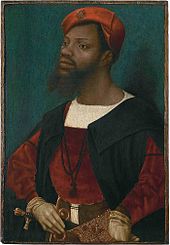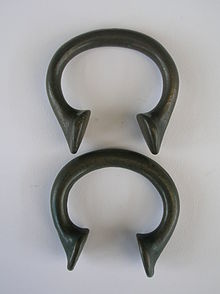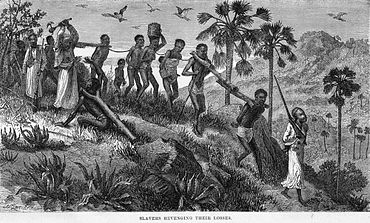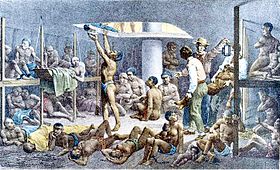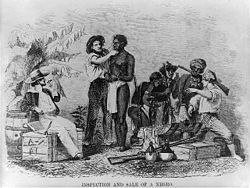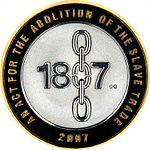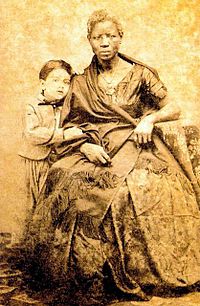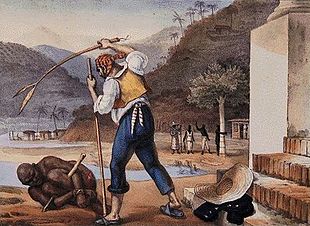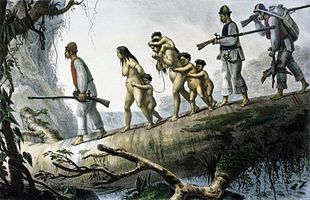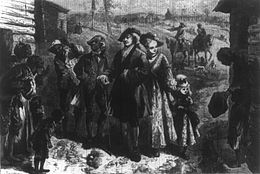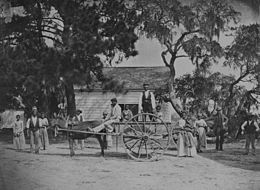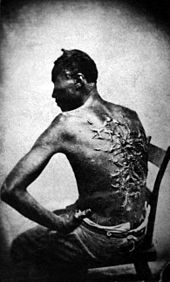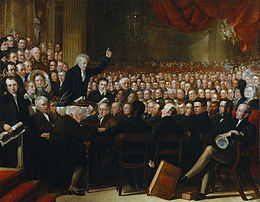
History of slavery
Did you know...
SOS Children has tried to make Wikipedia content more accessible by this schools selection. SOS mothers each look after a a family of sponsored children.
| Slavery |
|---|
| Contemporary |
|
| Types |
|
| Historic |
|
| By country or region |
|
| Religion |
|
| Opposition and resistance |
|
| Related topics |
|
The history of slavery covers slave systems in historical perspective in which one human being is legally the property of another, can be bought or sold, is not allowed to escape and must work for the owner without any choice involved. As Drescher (2009) argues, "The most crucial and frequently utilized aspect of the condition is a communally recognized right by some individuals to possess, buy, sell, discipline, transport, liberate, or otherwise dispose of the bodies and behaviour of other individuals." An integral element is that children of a slave mother automatically become slaves. It does not include historical forced labor by prisoners, labor camps, or other forms of unfree labor in which laborers are not considered property.
Slavery can be traced back to the earliest records, such as the Code of Hammurabi (c. 1760 BC), which refers to it as an established institution. Slavery is rare among hunter-gatherer populations as slavery depends on a system of social stratification. Slavery typically also requires a shortage of labor and a surplus of land to be viable. David P. Forsythe wrote: "The fact remained that at the beginning of the nineteenth century an estimated three-quarters of all people alive were trapped in bondage against their will either in some form of slavery or serfdom."
Slavery is no longer legal anywhere in the world. Mauritania abolished it in law in 1981 and was the last country to do so – see Abolition of slavery timeline. However, the number of slaves today is higher than at any point in history, remaining as high as 12 million to 27 million.
Origins
Evidence of slavery predates written records, and has existed in many cultures. Slavery is rare among hunter–gatherer populations, as slavery is a system of social stratification. Mass slavery also requires economic surpluses and a high population density to be viable. Due to these factors, the practice of slavery would have only proliferated after the invention of agriculture during the Neolithic Revolution about 11,000 years ago.
Slavery was known in civilizations as old as Sumer, as well as almost every other ancient civilization, including Ancient Egypt, Ancient China, the Akkadian Empire, Assyria, Ancient India, Ancient Greece, the Roman Empire, the Islamic Caliphate, and the pre-Columbian civilizations of the Americas. Such institutions were a mixture of debt-slavery, punishment for crime, the enslavement of prisoners of war, child abandonment, and the birth of slave children to slaves.
Europe
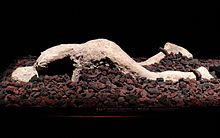
Ancient Greece
Records of slavery in Ancient Greece go as far back as Mycenaean Greece. The origins are not known, but it appears that slavery became an important part of the economy and society only after the establishment of cities. Slavery was common practice and an integral component of ancient Greece throughout its rich history, as it was in other societies of the time including ancient Israel and early Christian societies. It is estimated that in Athens, the majority of citizens owned at least one slave. Most ancient writers considered slavery not only natural but necessary, but some isolated debate began to appear, notably in Socratic dialogues while the Stoics produced the first condemnation of slavery recorded in history.
During the 8th and the 7th centuries BC, in the course of the two Messenian Wars the Spartans reduced an entire population to a pseudo-slavery called helotry. According to Herodotus (IX, 28–29), helots were seven times as numerous as Spartans. Following several helot revolts around the year 600 BC, the Spartans restructured their city-state along authoritarian lines, for the leaders decided that only by turning their society into an armed camp could they hope to maintain control over the numerically dominant helot population. In some Ancient Greek city states about 30% of the population consisted of slaves, but paid and slave labor seem to have been equally important.
Rome
Romans inherited the institution of slavery from the Greeks and the Phoenicians. As the Roman Republic expanded outward, entire populations were enslaved, thus creating an ample supply to work in Rome's farms and households. The people subjected to Roman slavery came from all over Europe and the Mediterranean. Such oppression by an elite minority eventually led to slave revolts; the Third Servile War led by Spartacus was the most famous and severe. Greeks, Berbers, Germans, Britons, Slavs, Thracians, Gauls (or Celts), Jews, Arabs, and many more were slaves used not only for labor, but also for amusement (e.g. gladiators and sex slaves). If a slave ran away, he was liable to be crucified. By the late Republican era, slavery had become a vital economic pillar in the wealth of Rome. In the Roman Empire, probably over 25% of the empire's population, and 30 to 40% of the population of Italy was enslaved.
Celtic Tribes
Celtic tribes of Europe are recorded by various Roman sources as owning slaves. The extent of slavery in prehistorical Europe is not well known however.
In the Viking era beginning circa 793, the Norse raiders often captured and enslaved militarily weaker peoples they encountered. In the Nordic countries the slaves were called thralls ( Old Norse: Þræll). The thralls were mostly from Western Europe, among them many Franks, Anglo-Saxons, and Celts. Many Irish slaves participated in the colonization of Iceland. There is evidence of German, Baltic, Slavic and Latin slaves as well. The slave trade was one of the pillars of Norse commerce during the 6th through 11th centuries. The Persian traveller Ibn Rustah described how Swedish Vikings, the Varangians or Rus, terrorized and enslaved the Slavs. The thrall system was finally abolished in the mid-14th century in Scandinavia.
Middle Ages
Chaos and invasion made the taking of slaves habitual throughout Europe in the early Middle Ages. St. Patrick, himself captured and sold as a slave, protested against an attack that enslaved newly baptized Christians in his Letter to the Soldiers of Coroticus.
Slavery during the Early Middle Ages had several distinct sources. Jewish participation in the slave trade was recorded starting in the 5th century. After the Muslim conquests of North Africa and most of the Iberian peninsula, the Islamic world became a huge importer of Saqaliba (Slavic) slaves from central and eastern Europe. Olivia Remie Constable wrote: "Muslim and Jewish merchants brought slaves into al-Andalus from eastern Europe and Christian Spain, and then re-exported them to other regions of the Islamic world." This trade came to an end after the Christianisation of Slavic countries. The etymology of the word slave comes from this period, the word sklabos meaning Slav.
The Vikings raided across Europe, though their slave raids were the most destructive in the British Isles and Eastern Europe. While the Vikings kept some slaves for themselves as servants, known as thralls, most people captured by the Vikings would be sold on the Byzantine or Islamic markets. In the West the targets of Viking slavery were primarily English, Irish, and Scottish, while in the East they were mainly Slavs. The Viking slave trade slowly ended in the 11th century, as the Vikings settled in the European territories they once raided, Christianized serfdom, and merged with the local populace.
The Islamic World was a main factor slavery. Although slavery had different implications for slaves:(i) Islamic law forbade Muslims to enslave fellow Muslims or so-called People of the Book: Christians, Jews, and Zoroastrians. (ii) If they converted to Islam their master had the obligation to free them and if they did not they have to teach them. (iii) Slaves could rise socially by marriage and attain high office. (iv) The principal requirement was for military service. However, Muslims did not always treat with slaves in accordance with Islamic law. The Muslim powers of Iberia both raided for slaves and purchased slaves from European merchants, often the Jewish Radhanites, one of the few groups that could easily move between the Christian and Islamic worlds. The Middle Ages from 1100 to 1500 saw a continuation of the European slave trade, though with a shift from the Western Mediterranean Islamic nations to the Eastern, as Venice and Genoa, in firm control of the Eastern Mediterranean from the 12th century and the Black Sea from the 13th century sold both Slavic and Baltic slaves, as well as Georgians, Turks, and other ethnic groups of the Black Sea and Caucasus, to the Muslim nations of the Middle East. The sale of European slaves by Europeans slowly ended as the Slavic and Baltic ethnic groups Christianized by the Late Middle Ages. European slaves in the Islamic World would, however, continue into the Modern time period as Muslim pirates, primarily Algerians, with the support of the Ottoman Empire, raided European coasts and shipping from the 16th to the 19th centuries, ending their attacks with the naval decline of the Ottoman Empire in the late 16th and 17th centuries, as well as the European conquest of North Africa throughout the 19th century.
The Mongol invasions and conquests in the 13th century made the situation worse. The Mongols enslaved skilled individuals, women and children and marched them to Karakorum or Sarai, whence they were sold throughout Eurasia. Many of these slaves were shipped to the slave market in Novgorod.
Slave commerce during the Late Middle Ages was mainly in the hands of Venetian and Genoese merchants and cartels, who were involved in the slave trade with the Golden Horde. In 1382 the Golden Horde under Khan Tokhtamysh sacked Moscow, burning the city and carrying off thousands of inhabitants as slaves. Between 1414 and 1423, some 10,000 eastern European slaves were sold in Venice. Genoese merchants organized the slave trade from the Crimea to Mamluk Egypt. For years the Khanates of Kazan and Astrakhan routinely made raids on Russian principalities for slaves and to plunder towns. Russian chronicles record about 40 raids of Kazan Khans on the Russian territories in the first half of the 16th century. In 1521, the combined forces of Crimean Khan Mehmed Giray and his Kazan allies attacked Moscow and captured thousands of slaves.
In 1441, Haci I Giray declared independence from the Golden Horde and established the Crimean Khanate. For a long time, until the early 18th century, the khanate maintained a massive slave trade with the Ottoman Empire and the Middle East. In a process called the "harvesting of the steppe", they enslaved many Slavic peasants. About 30 major Tatar raids were recorded into Muscovite territories between 1558 and 1596. In 1571, the Crimean Tatars attacked and sacked Moscow, burning everything but the Kremlin and taking thousands of captives as slaves. In Crimea, about 75% of the population consisted of slaves.
Medieval Spain and Portugal were the scene of almost constant warfare between Muslims and Christians. Periodic raiding expeditions were sent from Al-Andalus to ravage the Iberian Christian kingdoms, bringing back booty and slaves. In a raid against Lisbon, Portugal in 1189, for example, the Almohad caliph Yaqub al-Mansur took 3,000 female and child captives, while his governor of Córdoba, in a subsequent attack upon Silves, Portugal in 1191, took 3,000 Christian slaves.
The Byzantine-Ottoman wars and the Ottoman wars in Europe brought large numbers of Christian slaves into the Islamic world too. After the battle of Lepanto approximately 12,000 Christian galley slaves were freed from the Ottoman fleet. Christians were also selling Muslim slaves captured in war. The Knights of Malta attacked pirates and Muslim shipping, and their base became a centre for slave trading, selling captured North Africans and Turks. Malta remained a slave market until well into the late 18th century. It required a thousand slaves to equip merely the galleys (ships) of the Order.
Slavery in Poland was forbidden in the 15th century; in Lithuania, slavery was formally abolished in 1588; they were replaced by the second enserfment. Slavery remained a minor institution in Russia until the 1723, when the Peter the Great converted the household slaves into house serfs. Russian agricultural slaves were formally converted into serfs earlier in 1679. The runaway Polish and Russian serfs and kholops known as Cossacks ('outlaws') formed autonomous communities in the southern steppes.
Portugal
The 15th-century Portuguese exploration of the African coast is commonly regarded as the harbinger of European colonialism. In 1452, Pope Nicholas V issued the papal bull Dum Diversas, granting Afonso V of Portugal the right to reduce any "Saracens, pagans and any other unbelievers" to hereditary slavery which legitimized slave trade under Catholic beliefs of that time. This approval of slavery was reaffirmed and extended in his Romanus Pontifex bull of 1455. These papal bulls came to serve as a justification for the subsequent era of slave trade and European colonialism. Although for a short period as in 1462, Pius II declared slavery to be "a great crime". The followers of the church of England and Protestants did not use the papal bull as a justification. The position of the church was to condemn the slavery of Christians, but slavery was regarded as an old established and necessary institution which supplied Europe with the necessary workforce. In the 16th century African slaves had substituted almost all other ethnicities and religious enslaved groups in Europe. Within the Portuguese territory of Brazil, and even beyond its original borders, the enslavement of native Americans was carried out by the Bandeirantes.
Among many other European slave markets, Genoa, and Venice were some well-known markets, their importance and demand growing after the great plague of the 14th century which decimated much of the European work force. The maritime town of Lagos, Portugal, was the first slave market created in Portugal for the sale of imported African slaves – the Mercado de Escravos, opened in 1444. In 1441, the first slaves were brought to Portugal from northern Mauritania. Prince Henry the Navigator, major sponsor of the Portuguese African expeditions, as of any other merchandise, taxed one fifth of the selling price of the slaves imported to Portugal. By the year 1552 African slaves made up 10 percent of the population of Lisbon. In the second half of the 16th century, the Crown gave up the monopoly on slave trade and the focus of European trade in African slaves shifted from import to Europe to slave transports directly to tropical colonies in the Americas – in the case of Portugal, especially Brazil. In the 15th century one third of the slaves were resold to the African market in exchange of gold.
As Portugal increased its presence along China's coast, they began trading in slaves. Many Chinese slaves were sold to Portugal. Since the 16th century Chinese slaves existed in Portugal, most of them were Chinese children and a large amount were shipped to the Indies. Chinese prisoners were sent to Portugal, where they were sold as slaves, they were prized and regarded better than moorish and black slaves. The first known visit of a Chinese person to Europe dates to 1540, when a Chinese scholar, enslaved during one of several Portuguese raids somewhere on the southern China coast, was brought to Portugal. Purchased by João de Barros, he worked with the Portuguese historian on translating Chinese texts into Portuguese. Dona Maria de Vilhena, a Portuguese noble woman from Évora, Portugal, owned a Chinese male slave in 1562. In the 16th century, a small number of Chinese slaves, around 29–34 people were in southern Portugal, where they were used in agricultural labor. Chinese boys were captured in China, and through Macau were brought to Portugal and sold as slaves in Lisbon. Some were then sold in Brazil, a Portuguese colony. Due to hostility from the Chinese regarding the trafficking in Chinese slaves, in 1595 a law was passed by Portugal banning the selling and buying of Chinese slaves. On 19 February 1624, the King of Portugal forbade the enslavement of Chinese of either sex.
Spain
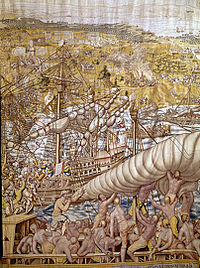
The Spaniards were the first Europeans to use African slaves in the New World on islands such as Cuba and Hispaniola, where the native population starved themselves rather than work for the Spanish. Although the natives were used as forced labor (the Spanish employed the pre-Columbian draft system called the mita), the spread of disease caused a shortage of labor, and so the Spanish colonists gradually became involved in the Atlantic slave trade. The first African slaves arrived in Hispaniola in 1501; by 1517, the natives had been "virtually annihilated" by the settlers.
Netherlands
Although slavery was illegal inside the Netherlands it flourished in the Dutch Empire, and helped support the economy. By 1650 the Dutch had the pre-eminent slave trade in Europe. They were overtaken by Britain around 1700. Historians agree that in all the Dutch shipped about 550,000 African slaves across the Atlantic, about 75,000 of whom died on board before reaching their destinations. From 1596 to 1829, the Dutch traders sold 250,000 slaves in the Dutch Guianas, 142,000 in the Dutch Caribbean islands, and 28,000 in Dutch Brazil. In addition, tens of thousands of slaves, mostly from India and some from Africa, were carried to the Dutch East Indies.
Great Britain and Ireland
Slavery was practised by the Romans, but when they left in the 5th century they took their slaves with them. Anglo-Saxon Germanic settlers brought in slaves. Capture in war, voluntary servitude and debt slavery became common, and slaves were routinely bought and sold, but running away was common and slavery was never a major economic factor. Ireland and Denmark were markets for captured Anglo Saxon and Celtic slaves. Pope Gregory I reputedly made the pun, Non Angli, sed Angeli ("Not Angles, but Angels"), after a response to his query regarding the identity of a group of fair-haired Angles slave children whom he had observed in the marketplace. After 1100 slavery faded away as uneconomical.
Barbary Corsairs
From the 16th to 19th century, Barbary Corsairs raided the coasts of Europe and attacked lone ships at sea. From 1609 to 1616, England lost 466 merchant ships to Barbary pirates. 160 English ships were captured by Algerians between 1677 and 1680. Many of the captured sailors were made into slaves and held for ransom. The corsairs were no strangers to the South West of England where raids were known in a number of coastal communities. In 1627 Barbary Pirates under command of the Dutch renegade Jan Janszoon operating from the Moroccan port of Salé occupied the island of Lundy. During this time there were reports of captured slaves being sent to Algiers.
Ireland, despite its northern position, was not immune from attacks by the corsairs. In June 1631 Murat Reis, with pirates from Algiers and armed troops of the Ottoman Empire, stormed ashore at the little harbour village of Baltimore, County Cork. They captured almost all the villagers and took them away to a life of slavery in North Africa. The prisoners were destined for a variety of fates—some lived out their days chained to the oars as galley slaves, while others would spend long years in the scented seclusion of the harem or within the walls of the sultan's palace. Only two of them ever saw Ireland again.
Atlantic slave trade
Britain played a prominent role in the Atlantic slave trade, especially after 1600. Slavery was a legal institution in all of the 13 American colonies and Canada (acquired by Britain in 1763). The profits of the slave trade and of West Indian plantations amounted to 5% of the British economy at the time of the Industrial Revolution. The Somersett's case in 1772 was generally taken at the time to have decided that the condition of slavery did not exist under English law in England. In 1785, English poet William Cowper wrote: "We have no slaves at home – Then why abroad? Slaves cannot breathe in England; if their lungs receive our air, that moment they are free. They touch our country, and their shackles fall. That's noble, and bespeaks a nation proud. And jealous of the blessing. Spread it then, And let it circulate through every vein." In 1807, following many years of lobbying by the Abolitionist movement, the British Parliament voted to make the slave trade illegal anywhere in the Empire with the Slave Trade Act 1807. Thereafter Britain took a prominent role in combating the trade, and slavery itself was abolished in the British Empire with the Slavery Abolition Act 1833. Between 1808 and 1860, the West Africa Squadron seized approximately 1,600 slave ships and freed 150,000 Africans who were aboard. Action was also taken against African leaders who refused to agree to British treaties to outlaw the trade, for example against "the usurping King of Lagos", deposed in 1851. Anti-slavery treaties were signed with over 50 African rulers. In 1839, the world's oldest international human rights organization, Anti-Slavery International, was formed in Britain by Joseph Sturge, which worked to outlaw slavery in other countries.
In 1811, Arthur William Hodge was the first slave owner executed for the murder of a slave in the British West Indies. He was not, however, as some have claimed, the first white person to have been lawfully executed for the killing of a slave.
Pre-industrial Europe
It became the custom among the Mediterranean powers to sentence condemned criminals to row in the war- galleys of the state (initially only in time of war). The French Huguenots filled the galleys after the revocation of the Edict of Nantes in 1685 and Camisard rebellion. Galley-slaves lived in unsavoury conditions, so even though some sentences prescribed a restricted number of years, most rowers would eventually die, even if they survived shipwreck and slaughter or torture at the hands of enemies or of pirates. Naval forces often turned 'infidel' prisoners-of-war into galley-slaves. Several well-known historical figures served time as galley slaves after being captured by the enemy—the Ottoman corsair and admiral Turgut Reis and the Knights Hospitaller Grand Master Jean Parisot de la Valette among them.
From the 1440s into the 18th century hundreds of thousands of Ukrainians were sold into slavery to the Turks. In 1575, the Tatars captured over 35,000 Ukrainians; a 1676 raid took almost 40,000. About 60,000 Ukrainians were captured in 1688; some were ransomed, but most were sold into slavery. Some of the Roma people were enslaved over five centuries in Romania until abolition in 1864 (see Slavery in Romania).
Denmark-Norway was the first European country to ban the slave trade. This happened with a decree issued by the king in 1792, to become fully effective by 1803. Slavery itself was not banned until 1848. At this time Iceland was a part of Denmark-Norway but slave trading had been abolished in Iceland in 1117 and had never been reestablished.
Slavery in the French Republic was abolished on 4 February 1794 however it was re-established by Napoleon Bonaparte in 1804. Slavery would be permanently abolished in the French empire during the French Revolution of 1848. The Haitian Revolution established Haiti as a free republic ruled by blacks, the first of its kind. At the time of the revolution, Haiti was known as Saint-Domingue and was a colony of France.
Modern Europe
During The Holocaust, the Germans used slave labor from across occupied Europe to support their war effort, and numbering perhaps 6 million people.
The communist Soviet Union had about 14 million people working in Gulags during its existence. This camp system was also used to colonize Siberia.
Africa
In most African societies, there was very little difference between the free peasants and the feudal vassal peasants. Vassals of the Songhay Muslim Empire were used primarily in agriculture; they paid tribute to their masters in crop and service but they were slightly restricted in custom and convenience. These people were more an occupational caste, as their bondage was relative. In the Kanem Bornu Empire, vassals were three classes beneath the nobles. Marriage between captor and captive was far from rare, blurring the anticipated roles.
French historian Fernand Braudel noted that slavery was endemic in Africa and part of the structure of everyday life. "Slavery came in different disguises in different societies: there were court slaves, slaves incorporated into princely armies, domestic and household slaves, slaves working on the land, in industry, as couriers and intermediaries, even as traders" (Braudel 1984 p. 435). During the 16th century, Europe began to outpace the Arab world in the export traffic, with its slave traffic from Africa to the Americas. The Dutch imported slaves from Asia into their colony in South Africa. In 1807 Britain, which held extensive, although mainly coastal colonial territories on the African continent (including southern Africa), made the international slave trade illegal, as did the United States in 1808. The end of the slave trade and the decline of slavery was imposed upon Africa by outside powers.
The nature of the slave societies differed greatly across the continent. There were large plantations worked by slaves in Egypt, the Sudan and Zanzibar, but this was not a typical use of slaves in Africa as a whole. In most African slave societies, slaves were protected and incorporated into the slave-owning family.
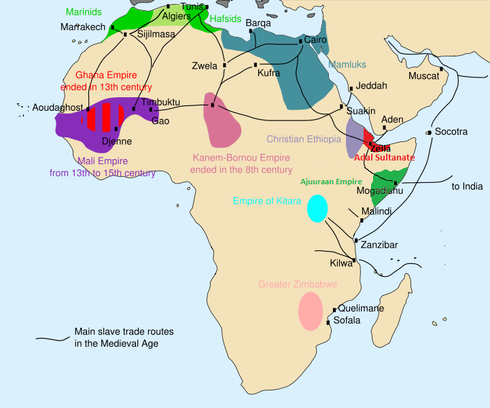
In Senegambia, between 1300 and 1900, close to one-third of the population was enslaved. In early Islamic states of the western Sudan, including Ghana (750–1076), Mali (1235–1645), Segou (1712–1861), and Songhai (1275–1591), about a third of the population were slaves. In Sierra Leone in the 19th century about half of the population consisted of slaves. In the 19th century at least half the population was enslaved among the Duala of the Cameroon, the Igbo and other peoples of the lower Niger, the Kongo, and the Kasanje kingdom and Chokwe of Angola. Among the Ashanti and Yoruba a third of the population consisted of slaves. The population of the Kanem was about a third-slave. It was perhaps 40% in Bornu (1396–1893). Between 1750 and 1900 from one- to two-thirds of the entire population of the Fulani jihad states consisted of slaves. The population of the Sokoto caliphate formed by Hausas in the northern Nigeria and Cameroon was half-slave in the 19th century. It is estimated that up to 90% of the population of Arab- Swahili Zanzibar was enslaved. Roughly half the population of Madagascar was enslaved.
The Anti-Slavery Society estimated that there were 2,000,000 slaves in the early 1930s Ethiopia, out of an estimated population of between 8 and 16 million. Slavery continued in Ethiopia until the brief Second Italo-Abyssinian War in October 1935, when it was abolished by order of the Italian occupying forces. In response to pressure by Western Allies of World War II Ethiopia officially abolished slavery and serfdom after regaining its independence in 1942. On 26 August 1942 Haile Selassie issued a proclamation outlawing slavery.
When British rule was first imposed on the Sokoto Caliphate and the surrounding areas in northern Nigeria at the turn of the 20th century, approximately 2 million to 2.5 million people there were slaves. Slavery in northern Nigeria was finally outlawed in 1936.
Elikia M'bokolo, April 1998, Le Monde diplomatique. Quote: "The African continent was bled of its human resources via all possible routes. Across the Sahara, through the Red Sea, from the Indian Ocean ports and across the Atlantic. At least ten centuries of slavery for the benefit of the Muslim countries (from the ninth to the nineteenth)." He continues: "Four million slaves exported via the Red Sea, another four million through the Swahili ports of the Indian Ocean, perhaps as many as nine million along the trans-Saharan caravan route, and eleven to twenty million (depending on the author) across the Atlantic Ocean"
Sub-Saharan Africa
David Livingstone wrote of the slave trades:
"To overdraw its evils is a simple impossibility.... We passed a slave woman shot or stabbed through the body and lying on the path. [Onlookers] said an Arab who passed early that morning had done it in anger at losing the price he had given for her, because she was unable to walk any longer. We passed a woman tied by the neck to a tree and dead.... We came upon a man dead from starvation.... The strangest disease I have seen in this country seems really to be broken heartedness, and it attacks free men who have been captured and made slaves."
Livingstone estimated that 80,000 Africans died each year before ever reaching the slave markets of Zanzibar. Zanzibar was once East Africa's main slave-trading port, and under Omani Arabs in the 19th century as many as 50,000 slaves were passing through the city each year.
Prior to the 16th century, the bulk of slaves exported from Africa were shipped from East Africa to the Arabian peninsula. Zanzibar became a leading port in this trade. Arab slave traders differed from European ones in that they would often conduct raiding expeditions themselves, sometimes penetrating deep into the continent. They also differed in that their market greatly preferred the purchase of female slaves over male ones.
The increased presence of European rivals along the East coast led Arab traders to concentrate on the overland slave caravan routes across the Sahara from the Sahel to North Africa. The German explorer Gustav Nachtigal reported seeing slave caravans departing from Kukawa in Bornu bound for Tripoli and Egypt in 1870. The slave trade represented the major source of revenue for the state of Bornu as late as 1898. The eastern regions of the Central African Republic have never recovered demographically from the impact of 19th-century raids from the Sudan and still have a population density of less than 1 person/km². During the 1870s, European initiatives against the slave trade caused an economic crisis in northern Sudan, precipitating the rise of Mahdist forces. Mahdi's victory created an Islamic state, one that quickly reinstituted slavery.
The Middle Passage, the crossing of the Atlantic to the Americas, endured by slaves laid out in rows in the holds of ships, was only one element of the well-known triangular trade engaged in by Portuguese, Dutch, French and British. Ships having landed slaves in Caribbean ports would take on sugar, indigo, raw cotton, and later coffee, and make for Liverpool, Nantes, Lisbon or Amsterdam. Ships leaving European ports for West Africa would carry printed cotton textiles, some originally from India, copper utensils and bangles, pewter plates and pots, iron bars more valued than gold, hats, trinkets, gunpowder and firearms and alcohol. Tropical shipworms were eliminated in the cold Atlantic waters, and at each unloading, a profit was made.
The Atlantic slave trade peaked in the late 18th century, when the largest number of slaves were captured on raiding expeditions into the interior of West Africa. These expeditions were typically carried out by African states, such as the Oyo empire ( Yoruba), Kong Empire, Kingdom of Benin, Imamate of Futa Jallon, Imamate of Futa Toro, Kingdom of Koya, Kingdom of Khasso, Kingdom of Kaabu, Fante Confederacy, Ashanti Confederacy, Aro Confederacy and the kingdom of Dahomey. Europeans rarely entered the interior of Africa, due to fear of disease and moreover fierce African resistance. The slaves were brought to coastal outposts where they were traded for goods. The people captured on these expeditions were shipped by European traders to the colonies of the New World. As a result of the War of the Spanish Succession, the United Kingdom obtained the monopoly ( asiento de negros) of transporting captive Africans to Spanish America. It is estimated that over the centuries, twelve to twenty million people were shipped as slaves from Africa by European traders, of whom some 15 percent died during the terrible voyage, many during the arduous journey through the Middle Passage. The great majority were shipped to the Americas, but some also went to Europe and Southern Africa.
Christian Slaves
In Algiers, the capital of Algeria in Northern Africa, Christians and Europeans that were captured and forced into slavery. This eventually led to the Bombardment of Algiers in 1816.
African participation in the slave trade
Some African states played a role in the slave trade. They would sell their captives or prisoners of war to European buyers. Selling captives or prisoners was common practice among Africans and Arabs during that era. However, as the Atlantic slave trade increased its demand, local systems which primarily serviced indentured servitude became corrupted and started to supply the European slave traders, changing social dynamics. It also ultimately undermined local economies and political stability as villages' vital labor forces were shipped overseas as slave raids and civil wars became commonplace. Crimes which were previously punishable by some other punishment became punishable by enslavement.
The prisoners and captives that were sold were usually from neighboring or enemy ethnic groups. These captive slaves were not considered as part of the ethnic group or 'tribe' and kings did not have a particular loyalty to them. At times, kings and chiefs would sell criminals into slavery so that they could no longer commit crimes in that area. Most other slaves were obtained from kidnappings, or through raids that occurred at gunpoint through joint ventures with the Europeans. Some African kings refused to sell any of their captives or criminals. King Jaja of Opobo, a former slave himself, completely refused to do business with slavers. Ashanti King Agyeman Prempeh (Ashanti king, b. 1872) also sacrificed his own freedom so that his people would not face collective slavery.
The viewpoint that “Africans” enslaved “Africans” is obfuscating if not troubling. The deployment of “African” in African history tends to coalesce into obscurantist constructions of identities that allow scholars, for instance, to subtly call into question the humanity of “all” Africans. Whenever Asante rulers sold non-Asantes into slavery, they did not construct it in terms of Africans selling fellow Africans. They saw the victims for what they were, for instance, as Akuapems, without categorizing them as fellow Africans. Equally, when Christian Scandinavians and Russians sold war captives to the Islamic people of the Abbasid Empire, they didn’t think that they were placing fellow Europeans into slavery. This lazy categorizing homogenizes Africans and has become a part of the methodology of African history; not surprisingly, the Western media’s cottage industry on Africa has tapped into it to frame Africans in inchoate generalities allowing the media to describe local crisis in one African state as “African” problem.
— Dr. Akurang-Parry, Ending the Slavery Blame
Before the arrival of the Portuguese, slavery had already existed in Kingdom of Kongo. Despite its establishment within his kingdom, Afonso I of Kongo believed that the slave trade should be subject to Kongo law. When he suspected the Portuguese of receiving illegally enslaved persons to sell, he wrote letters to the King João III of Portugal in 1526 imploring him to put a stop to the practice.
The kings of Dahomey sold their war captives into transatlantic slavery, who otherwise would have been killed in a ceremony known as the Annual Customs. As one of West Africa's principal slave states, Dahomey became extremely unpopular with neighbouring peoples. Like the Bambara Empire to the east, the Khasso kingdoms depended heavily on the slave trade for their economy. A family's status was indicated by the number of slaves it owned, leading to wars for the sole purpose of taking more captives. This trade led the Khasso into increasing contact with the European settlements of Africa's west coast, particularly the French. Benin grew increasingly rich during the 16th and 17th centuries on the slave trade with Europe; slaves from enemy states of the interior were sold, and carried to the Americas in Dutch and Portuguese ships. The Bight of Benin's shore soon came to be known as the "Slave Coast".
In the 1840s, King Gezo of Dahomey said:
"The slave trade is the ruling principle of my people. It is the source and the glory of their wealth…the mother lulls the child to sleep with notes of triumph over an enemy reduced to slavery…"
In 1807, the UK Parliament passed the Bill that abolished the trading of slaves. The King of Bonny (now in Nigeria) was horrified at the conclusion of the practice:
"We think this trade must go on. That is the verdict of our oracle and the priests. They say that your country, however great, can never stop a trade ordained by God himself."
Some historians conclude that the total loss in persons removed, those who died on the arduous march to coastal slave marts and those killed in slave raids, far exceeded the 65–75 million inhabitants remaining in Sub-Saharan Africa at the trade's end. Others believe that slavers had a vested interest in capturing rather than killing, and in keeping their captives alive; and that this coupled with the disproportionate removal of males and the introduction of new crops from the Americas ( cassava, maize) would have limited general population decline to particular regions of western Africa around 1760–1810, and in Mozambique and neighbouring areas half a century later. There has also been speculation that within Africa, females were most often captured as brides, with their male protectors being a "bycatch" who would have been killed if there had not been an export market for them.
During the period from late 19th century and early 20th century, demand for the labor-intensive harvesting of rubber drove frontier expansion and slavery. The personal monarchy of Belgian King Leopold II in the Congo Free State saw mass killings and slavery to extract rubber.
Modern times
The trading of children has been reported in modern Nigeria and Benin. In parts of Ghana, a family may be punished for an offense by having to turn over a virgin female to serve as a sex slave within the offended family. In this instance, the woman does not gain the title or status of "wife". In parts of Ghana, Togo, and Benin, shrine slavery persists, despite being illegal in Ghana since 1998. In this system of ritual servitude, sometimes called trokosi (in Ghana) or voodoosi in Togo and Benin, young virgin girls are given as slaves to traditional shrines and are used sexually by the priests in addition to providing free labor for the shrine.
It is estimated that as many as 200,000 black south Sudanese children and women (mostly from the Dinka tribe sold by the Sudanese Arabs of the north) have been taken into slavery in Sudan during the Second Sudanese Civil War. In Mauritania it is estimated that up to 600,000 men, women and children, or 20% of the population, are currently enslaved, many of them used as bonded labor. Slavery in Mauritania was criminalized in August 2007.
Evidence emerged in the late 1990s of systematic slavery in cacao plantations in West Africa; see the chocolate and slavery article.
The Americas
Among indigenous peoples
In Pre-Columbian Mesoamerica the most common forms of slavery were those of prisoners-of-war and debtors. People unable to pay back a debt could be sentenced to work as a slave to the person owed until the debt was worked off. Warfare was important to the Maya society, because raids on surrounding areas provided the victims required for human sacrifice, as well as slaves for the construction of temples. Most victims of human sacrifice were prisoners of war or slaves. According to Aztec writings, as many as 84,000 people were sacrificed at a temple inauguration in 1487. Slavery was not usually hereditary; children of slaves were born free. In the Inca Empire, workers were subject to a mita in lieu of taxes which they paid by working for the government. Each ayllu, or extended family, would decide which family member to send to do the work. It is unclear if this labor draft or corvée counts as slavery. The Spanish adopted this system, particularly for their silver mines in Bolivia.
Other slave-owning societies and tribes of the New World were, for example, the Tehuelche of Patagonia, the Comanche of Texas, the Caribs of Dominica, the Tupinambá of Brazil, the fishing societies, such as the Yurok, that lived along the coast from what is now Alaska to California, the Pawnee and Klamath. Many of the indigenous peoples of the Pacific Northwest Coast, such as the Haida and Tlingit, were traditionally known as fierce warriors and slave-traders, raiding as far as California. Slavery was hereditary, the slaves being prisoners of war. Among some Pacific Northwest tribes about a quarter of the population were slaves. One slave narrative was composed by an Englishman, John R. Jewitt, who had been taken alive when his ship was captured in 1802; his memoir provides a detailed look at life as a slave, and asserts that a large number were held.
Brazil
Slavery was a mainstay of the Brazilian colonial economy, especially in mining and sugar cane production. Brazil obtained 38% of all African slaves traded, and more than 3 million slaves were sent to this one country. Starting around 1550, the Portuguese began to trade African slaves to work the sugar plantations, once the native Tupi people deteriorated. Although Portuguese Prime Minister Marquês de Pombal abolished slavery in mainland Portugal on 12 February 1761, slavery continued in her overseas colonies. Slavery was practiced among all classes. Slaves were owned by upper and middle classes, by the poor, and even by other slaves.
From São Paulo, the Bandeirantes, adventurers mostly of mixed Portuguese and native ancestry, penetrated steadily westward in their search for Indian slaves. Along the Amazon river and its major tributaries, repeated slaving raids and punitive attacks left their mark. One French traveler in the 1740s described hundreds of miles of river banks with no sign of human life and once-thriving villages that were devastated and empty. In some areas of the Amazon Basin, and particularly among the Guarani of southern Brazil and Paraguay, the Jesuits had organized their Jesuit Reductions along military lines to fight the slavers. In the mid-to-late 19th century, many Amerindians were enslaved to work on rubber plantations.
Resistance and abolition
Escaped slaves formed Maroon communities which played an important role in the histories of Brazil and other countries such as Suriname, Puerto Rico, Cuba, and Jamaica. In Brazil, the Maroon villages were called palenques or quilombos. Maroons survived by growing vegetables and hunting. They also raided plantations. At these attacks, the maroons would burn crops, steal livestock and tools, kill slavemasters, and invite other slaves to join their communities.
Jean-Baptiste Debret, a French painter who was active in Brazil in the first decades of the 19th century, started out with painting portraits of members of the Brazilian Imperial family, but soon became concerned with the slavery of both blacks and indigenous inhabitants. His paintings on the subject (two appear on this page) helped bring attention to the subject in both Europe and Brazil itself.
The Clapham Sect, a group of evangelical reformers, campaigned during much of the 19th century for the United Kingdom to use its influence and power to stop the traffic of slaves to Brazil. Besides moral qualms, the low cost of slave-produced Brazilian sugar meant that British colonies in the West Indies were unable to match the market prices of Brazilian sugar, and each Briton was consuming 16 pounds (7 kg) of sugar a year by the 19th century. This combination led to intensive pressure from the British government for Brazil to end this practice, which it did by steps over several decades.
First, foreign slave trade was banned in 1850. Then, in 1871, the sons of the slaves were freed. In 1885, slaves aged over 60 years were freed. The Paraguayan War contributed to ending slavery, since many slaves enlisted in exchange for freedom. In Colonial Brazil, slavery was more a social than a racial condition. In fact, some of the greatest figures of the time, like the writer Machado de Assis and the engineer André Rebouças had black ancestry.
Brazil's 1877–78 Grande Seca (Great Drought) in the cotton-growing northeast led to major turmoil, starvation, poverty and internal migration. As wealthy plantation holders rushed to sell their slaves south, popular resistance and resentment grew, inspiring numerous emancipation societies. They succeeded in banning slavery altogether in the province of Ceará by 1884. Slavery was legally ended nationwide on 13 May by the Lei Aurea ("Golden Law") of 1888. In fact, it was an institution in decadence at these times, as since the 1880s the country had begun to use European immigrant labor instead. Brazil was the last nation in the Western Hemisphere to abolish slavery.
Other South American countries
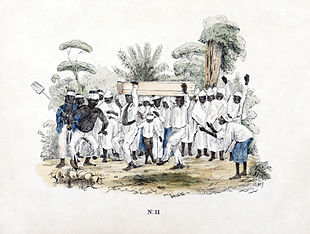
During the period from late 19th century and early 20th century, demand for the labor-intensive harvesting of rubber drove frontier expansion and slavery in Latin America and elsewhere. Indigenous people were enslaved as part of the rubber boom in Ecuador, Peru, Colombia, and Brazil. In Central America, rubber tappers participated in the enslavement of the indigenous Guatuso-Maleku people for domestic service.
British and French Caribbean
Slavery was commonly used in the parts of the Caribbean controlled by France and the British Empire. The Lesser Antilles islands of Barbados, St. Kitts, Antigua, Martinique and Guadeloupe, which were the first important slave societies of the Caribbean, began the widespread use of African slaves by the end of the 17th century, as their economies converted from sugar production.
By the middle of the 18th century, British Jamaica and French Saint-Domingue had become the largest slave societies of the region, and the Caribbean was rivaling Brazil as a destination for enslaved Africans. Due to overwork and tropical diseases, the death rates for Caribbean slaves were greater than birth rates. The conditions led to increasing numbers of slave revolts, escaped slaves forming Maroon communities and fighting guerrilla wars against the plantation owners.
To regularise slavery, in 1685 Louis XIV had enacted the code noir, which accorded certain human rights to slaves and responsibilities to the master, who was obliged to feed, clothe and provide for the general well-being of his slaves. Free blacks owned one-third of the plantation property and one-quarter of the slaves in Saint Domingue (later Haiti). Slavery in the French Republic was abolished on 4 February 1794. When it became clear that Napoleon intended to re-establish slavery in Haiti, Dessalines and Pétion switched sides, in October 1802. On 1 January 1804, Jean-Jacques Dessalines, the new leader under the dictatorial 1801 constitution, declared Haiti a free republic. Thus Haiti became the second independent nation in the Western Hemisphere, after the United States, and the only successful slave rebellion in world history.
Whitehall in England announced in 1833 that slaves in its territories would be totally freed by 1840. In the meantime, the government told slaves they had to remain on their plantations and would have the status of "apprentices" for the next six years.
In Port-of-Spain, Trinidad, on 1 August 1834, an unarmed group of mainly elderly Negroes being addressed by the Governor at Government House about the new laws, began chanting: "Pas de six ans. Point de six ans" ("Not six years. No six years"), drowning out the voice of the Governor. Peaceful protests continued until a resolution to abolish apprenticeship was passed and de facto freedom was achieved. Full emancipation for all was legally granted ahead of schedule on 1 August 1838, making Trinidad the first British colony with slaves to completely abolish slavery.
After Great Britain abolished slavery, it began to pressure other nations to do the same. France, too, abolished slavery. By then Saint-Domingue had already won its independence and formed the independent Republic of Haiti. French-controlled islands were then limited to a few smaller islands in the Lesser Antilles.
North America
Early events
The first slaves used by Europeans in what later became United States territory were among Lucas Vásquez de Ayllón's colonization attempt of North Carolina in 1526. The attempt was a failure, lasting only one year; the slaves revolted and fled into the wilderness to live among the Cofitachiqui people.
The first historically significant slave in what would become the United States was Estevanico, a Moroccan slave and member of the Narváez expedition in 1528 and acted as a guide on Fray Marcos de Niza's expedition to find the Seven Cities of Gold in 1539.
In 1619 twenty Africans were brought by a Dutch soldier and sold to the English colony of Jamestown, Virginia as indentured servants. It is possible that Africans were brought to Virginia prior to this, both because neither John Rolfe our source on the 1619 shipment nor any contemporary of his ever says that this was the first contingent of Africans to come to Virginia and because the 1625 Virginia census lists one black as coming on a ship that appears to only have landed people in Virginia prior to 1619. The transformation from indentured servitude to racial slavery happened gradually. It was not until 1661 that a reference to slavery entered into Virginia law, directed at Caucasian servants who ran away with a black servant. It was not until the Slave Codes of 1705 that the status of African Americans as slaves would be sealed. This status would last for another 160 years, until after the end of the American Civil War with the ratification of the 13th Amendment in December 1865.
Only a fraction of the enslaved Africans brought to the New World ended up in British North America—perhaps 5%. The vast majority of slaves shipped across the Atlantic were sent to the Caribbean sugar colonies, Brazil, or Spanish America.
By the 1680s with the consolidation of England's Royal African Company, enslaved Africans were imported to English colonies in larger numbers, and the practice continued to be protected by the English Crown. Colonists began purchasing slaves in larger numbers.
Slavery in American colonial law
- 1642: Massachusetts becomes the first colony to legalize slavery.
- 1650: Connecticut legalizes slavery.
- 1661: Virginia officially recognizes slavery by statute.
- 1662: A Virginia statute declares that children born would have the same status as their mother.
- 1663: Maryland legalizes slavery.
- 1664: Slavery is legalized in New York and New Jersey.
Development of slavery
The shift from indentured servants to African slaves was prompted by a dwindling class of former servants who had worked through the terms of their indentures and thus became competitors to their former masters. These newly freed servants were rarely able to support themselves comfortably, and the tobacco industry was increasingly dominated by large planters. This caused domestic unrest culminating in Bacon's Rebellion. Eventually, chattel slavery became the norm in regions dominated by plantations.
Many slaves in British North America were owned by plantation owners who lived in Britain. The British courts had made a series of contradictory rulings on the legality of slavery which encouraged several thousand slaves to flee the newly independent United States as refugees along with the retreating British in 1783. The British courts having ruled in 1772 that such slaves could not be forcibly returned to North America, the British government resettled them as free men in Sierra Leone.
Several slave rebellions took place during the 17th and 18th centuries.
Early United States law
Through the Northwest Ordinance of 1787 under the Congress of the Confederation, slavery was prohibited in the territories north west of the Ohio River. By 1804, abolitionists succeeded in passing legislation that would eventually (in conjunction with the 13th amendment) emancipate the slaves in every state north of the Ohio River and the Mason-Dixon Line. However, emancipation in the free states was so gradual that both New York and Pennsylvania listed slaves in their 1840 census returns, and a small number of black slaves were held in New Jersey in 1860. The importation or export of slaves was banned on 1 January 1808; but not the internal slave trade.
Despite the actions of abolitionists, free blacks were subject to racial segregation in the Northern states. Slavery was legal in most of Canada until 1833, but after that it offered a haven for hundreds of runaway slaves. Refugees from slavery fled the South across the Ohio River to the North via the Underground Railroad. Midwestern state governments asserted States Rights arguments to refuse federal jurisdiction over fugitives. Some juries exercised their right of jury nullification and refused to convict those indicted under the Fugitive Slave Act of 1850.
After the passage of the Kansas-Nebraska Act in 1854, armed conflict broke out in Kansas Territory, where the question of whether it would be admitted to the Union as a slave state or a free state had been left to the inhabitants. The radical abolitionist John Brown was active in the mayhem and killing in " Bleeding Kansas." The true turning point in public opinion is better fixed at the Lecompton Constitution fraud. Pro-slavery elements in Kansas had arrived first from Missouri and quickly organized a territorial government that excluded abolitionists. Through the machinery of the territory and violence, the pro-slavery faction attempted to force an unpopular pro-slavery constitution through the state. This infuriated Northern Democrats, who supported popular sovereignty, and was exacerbated by the Buchanan administration reneging on a promise to submit the constitution to a referendum – which it would surely fail. Anti-slavery legislators took office under the banner of the newly formed Republican Party. The Supreme Court in the Dred Scott decision of 1857 asserted that one could take one's property anywhere, even if one's property was chattel and one crossed into a free territory. It also asserted that African Americans could not be federal citizens. Outraged critics across the North denounced these episodes as the latest of the Slave Power (the politically organized slave owners) taking more control of the nation.
Civil War
Approximately one Southern family in four held slaves prior to war. According to the 1860 United States Census, about 385,000 individuals (i.e. 1.4% of White Americans in the country, or 4.8% of southern whites) owned one or more slaves. and the slave population in the United States stood at four million. 95% of blacks lived in the South, comprising one third of the population there as opposed to 1% of the population of the North. Consequently, fears of eventual emancipation were much greater in the South than in the North.
In the election of 1860, the Republicans swept Abraham Lincoln into the Presidency (with only 39.8% of the popular vote) and legislators into Congress. Lincoln however, did not appear on the ballots in most southern states and his election split the nation along sectional lines. After decades of controlling the Federal Government, several of the southern states declared they had seceded from the U.S. (the Union) in an attempt to form the Confederate States of America.
Northern leaders like Lincoln viewed the prospect of a new Southern nation, with control over the Mississippi River and the West, as unacceptable. This led to the outbreak of the Civil War, which spelled the end for chattel slavery in America. However, in August 1862, Lincoln wrote to editor Horace Greeley that despite his own moral objection to slavery, the objective of the war was to save the Union and not either to save or to destroy slavery . Lincoln's Emancipation Proclamation of 1863 was a powerful move that proclaimed freedom for slaves within the Confederacy as soon as the Union Army arrived; Lincoln had no power to free slaves in the border states or the rest of the Union, so he promoted the Thirteenth Amendment, which freed all the remaining slaves in December 1865. The proclamation made the abolition of slavery an official war goal and it was implemented as the Union captured territory from the Confederacy. Slaves in many parts of the south were freed by Union armies or when they simply left their former owners. Over 150,000 joined the Union Army and Navy as soldiers and sailors.
The remaining slaves within the United States remained enslaved until the final ratification of the Thirteenth Amendment to the Constitution on 6 December 1865 (with final recognition of the amendment on 18 December), eight months after the cessation of hostilities. Only in Kentucky did a significant slave population remain by that time, although there were some in West Virginia and Delaware.
After the failure of Reconstruction, freed slaves in the United States were treated as second class citizens. For decades after their emancipation, many former slaves living in the South sharecropped and had a low standard of living. In some states, it was only after the civil rights movement of the 1950s and 60s that blacks obtained legal protection from racial discrimination (see segregation).
Asia

Oceania
In the first half of the 19th century, small-scale slave raids took place across Polynesia to supply labor and sex workers for the whaling and sealing trades, with examples from both the westerly and easterly extremes of the Polynesian triangle. By the 1860s this had grown to a larger scale operation with Peruvian slave raids in the South Sea Islands to collect labor for the guano industry.
Hawaii
Ancient Hawaii was a caste society. People were born into specific social classes. Kauwa were the outcast or slave class. They are believed to have been war captives, or the descendents of war captives. Marriage between higher castes and the kauwa was strictly forbidden. The kauwa worked for the chiefs and were often used as human sacrifices at the luakini heiau. (They were not the only sacrifices; law-breakers of all castes or defeated political opponents were also acceptable as victims.)
New Zealand
In traditional Māori society of Aotearoa, prisoners of war became taurekareka, slaves, unless released, ransomed or tortured. With some exceptions, the child of a slave remained a slave. As far as it is possible to tell, slavery seems to have increased in the early 19th century, as a result of increased numbers of prisoners being taken by Māori military leaders such as Hongi Hika and Te Rauparaha in the Musket Wars, the need for labor to supply whalers and traders with food, flax and timber in return for western goods, and the missionary condemnation of cannibalism. Slavery was outlawed when the British annexed New Zealand in 1840, immediately prior to the signing of the Treaty of Waitangi, although it did not end completely until government was effectively extended over the whole of the country with the defeat of the Kingi movement in the Wars of the mid-1860s.
Chatham Islands
One group of Polynesians who migrated to the Chatham Islands became the Moriori who developed a largely pacifist culture. It was originally speculated that they settled the Chathams direct from Polynesia, but it is now widely believed they were disaffected Māori who emigrated from the South Island of New Zealand. Their pacifism left the Moriori unable to defend themselves when the islands were invaded by mainland Māori in the 1830s. Some 300 Moriori men, women and children were massacred and the remaining 1,200 to 1,300 survivors were enslaved.
Rapa Nui / Easter Island
The isolated island of Rapa Nui/Easter Island was inhabited by the Rapanui, who suffered a series of slave raids from 1805 or earlier, culminating in a near genocidal experience in the 1860s. The 1805 raid was by American sealers and was one of a series that changed the attitude of the islanders to outside visitors, with reports in the 1820s and 1830s that all visitors received a hostile reception. In December 1862, Peruvian slave raiders took between 1,400 and 2,000 islanders back to Peru to work in the guano industry; this was about a third of the island's population and included much of the island's leadership, the last ariki-mau and possibly the last who could read Rongorongo. After intervention by the French ambassador in Lima, the last 15 survivors were returned to the island, but brought with them smallpox, which further devastated the island.
Abolitionist movements
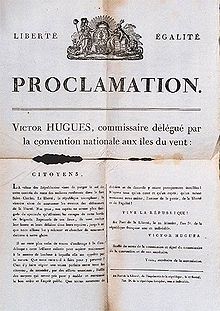
Slavery has existed, in one form or another, throughout the whole of human history. So, too, have movements to free large or distinct groups of slaves. However, abolitionism should be distinguished from efforts to help a particular group of slaves, or to restrict one practice, such as the slave trade.
Drescher (2009) provides a model for the history of the abolition of slavery, emphasizing its origins in Western Europe. Around the year 1500, slavery had virtually died out in Western Europe, but was a normal phenomenon practically everywhere else. The imperial powers, France, Spain, Britain, Portugal, the Netherlands and a few others, built worldwide empires based primarily on plantation agriculture using slaves imported from Africa. However, the powers took care to minimize the presence of slavery in their homelands. During the "Age of Revolutions" (c. 1770–1815), Britain abolished its international slave trade and imposed similar restrictions upon other western nations; the U.S. followed suit in 1808. Although there were numerous slave revolts in the Caribbean, the only successful uprising came in the French colony of St. Domingue, where the slaves rose up, killed the mulattoes and whites, and established the independent Republic of Haiti. The continuing profitability of slave-based plantations and the threats of race war slowed the development of abolition movements during the first half of the 19th century. These movements were strongest in Britain, and after 1840 in the United States, in both instances they were based on evangelical religious enthusiasm that stressed the horrible impact on the slaves themselves. The Northern states of the United States abolished slavery, partly in response to the Declaration of Independence, between 1777 and 1804. Britain ended slavery in its empire in the 1830s. However the plantation economies of the southern United States, based on cotton, and those in Brazil and Cuba, based on sugar, expanded and grew even more profitable. The bloody American Civil War ended slavery in the United States in the 1860s; the system ended in Cuba and Brazil in the 1880s because it was no longer profitable for the owners. Slavery continued to exist in Africa, where Arab slave traders raided black areas for new captives to be sold in the system. European colonial rule and diplomatic pressure slowly put an end to the trade, and eventually to the practice of slavery itself.
Britain
In 1772, the Somersett Case (R. v. Knowles, ex parte Somersett) of the English Court of King's Bench ruled that slavery was unlawful in England (although not elsewhere in the British Empire). A similar case, that of Joseph Knight, took place in Scotland five years later and ruled slavery to be contrary to the law of Scotland.
Following the work of campaigners in the United Kingdom, such as William Wilberforce and Thomas Clarkson, the Act for the Abolition of the Slave Trade was passed by Parliament on 25 March 1807, coming into effect the following year. The act imposed a fine of £100 for every slave found aboard a British ship. The intention was to outlaw entirely the Atlantic slave trade within the whole British Empire.
The significance of the abolition of the British slave trade lay in the number of people hitherto sold and carried by British slave vessels. Britain shipped 2,532,300 Africans across the Atlantic, equalling 41% of the total transport of 6,132,900 individuals. This made the British empire the biggest slave-trade contributor in the world due to the magnitude of the empire. A fact that made the abolition act all the more damaging to the global trade of slaves.
The Slavery Abolition Act, passed on 23 August 1833, outlawed slavery itself in the British colonies. On 1 August 1834 all slaves in the British West Indies, were emancipated, but still indentured to their former owners in an apprenticeship system. The intention of, was to educate former slaves to a trade but instead allowed slave owners to maintain ownership illegally. The act was finally repealed in 1838.
Britain abolished slavery in both Hindu and Muslim India by the Indian Slavery Act V. of 1843.
Domestic slavery practised by the educated African coastal elites (as well as interior traditional rulers) in Sierra Leone was abolished in 1928. A study found practices of domestic slavery still widespread in rural areas in the 1970s.
France
There were slaves in mainland France (especially in trade ports such as Nantes or Bordeaux)., but the institution was never officially authorized there. The legal case of Jean Boucaux in 1739 clarified the unclear legal position of possible slaves in France, and was followed by laws that established registers for slaves in mainland France, who were limited to a three-year stay, for visits or learning a trade. Unregistered "slaves" in France were regarded as free. However, slavery was of vital importance in France's Caribbean possessions, especially Saint-Domingue.
Abolition
In 1793, influenced by the French Declaration of the Rights of Man of August 1789 and alarmed as the massive slave revolt of August 1791 that had become the Haitian Revolution threatened to ally itself with the British, the French Revolutionary commissioners Sonthonax and Polverel declared general emancipation to reconcile them with France. In Paris, on 4 February 1794, Abbé Grégoire and the Convention ratified this action by officially abolishing slavery in all French territories outside mainland France, freeing all the slaves both for moral and security reasons.
Napoleon restores slavery
Napoleon came to power in 1799 and soon had grandiose plans for the French sugar colonies; to achieve them he had to reintroduce slavery. Napoleon's major adventure into the Caribbean--sending 30,000 troops in 1802 to retake Saint Domingue (Haiti) from ex-slaves under Toussaint L'Ouverture who had revolted. Napoleon wanted to preserve France's financial benefits from the colony's sugar and coffee crops; he then planned to establish a major base at New Orleans. He therefore reestablished slavery in Haiti and Guadeloupe, where it had been abolished after rebellions. Slaves and black freedmen fought the French for their freedom and independence. Revolutionary ideals played a central role in the fighting for it was the slaves and their comrades who were fighting for the revolutionary ideals of freedom and equality, while the French troops under General Charles Leclerc fought to restore the order of the ancien régime. The goal of reestablishing slavery - which explicitly contradicted the ideals of the French Revolution - demoralized the French troops. The demoralized French soldiers were unable to cope with the tropical diseases, and most died of yellow fever. Slavery was reimposed in Guadeloupe but not in Haiti, which became an independent black republic. Napoleon's vast colonial dreams for Egypt, India, the Caribbean, Louisiana, and even Australia were all doomed for lack of a fleet capable of matching Britain's Royal Navy. Realizing the fiasco Napoleon liquidated the Haiti project, brought home the survivors and sold off Louisiana to the U.S. in 1803
Slavery in the French colonies was finally abolished only in 1848, three months after the beginning of the revolution against the July Monarchy.
United States
In 1688, four German Quakers in Germantown presented a protest against the institution of slavery to their local Quaker Meeting. It was ignored for 150 years but in 1844 it was rediscovered and was popularized by the abolitionist movement. The 1688 Petition was the first American public document of its kind to protest slavery, and in addition was one of the first public documents to define universal human rights.
The American Colonization Society, the primary vehicle for returning black Americans to greater freedom in Africa, established the colony of Liberia in 1821–22, on the premise former American slaves would have greater freedom and equality there. The ACS assisted in the movement of thousands of African Americans to Liberia, with its founder Henry Clay stating; "unconquerable prejudice resulting from their colour, they never could amalgamate with the free whites of this country. It was desirable, therefore, as it respected them, and the residue of the population of the country, to drain them off". Abraham Lincoln, an enthusiastic supporter of Clay, adopted his position on returning the blacks to their own land.
Slaves in the United States who escaped ownership would often make their way to Canada via the " Underground Railroad". The more famous of the African American abolitionists include former slaves Harriet Tubman, Sojourner Truth and Frederick Douglass. Many more people who opposed slavery and worked for abolition were northern whites, such as William Lloyd Garrison and John Brown. Slavery was legally abolished in 1865 by the Thirteenth Amendment to the United States Constitution.
While abolitionists agreed on the evils of slavery, there were differing opinions on what should happen after African Americans were freed. By the time of Emancipation, African-Americans were now native to the United States and did not want to leave. Most believed that their labor had made the land theirs as well as that of the whites.
Congress of Vienna
The Declaration of the Powers, on the Abolition of the Slave Trade, of 8 February 1815 (Which also formed ACT, No. XV. of the Final Act of the Congress of Vienna of the same year) included in its first sentence the concept of the "principles of humanity and universal morality" as justification for ending a trade that was "odious in its continuance".
Twentieth century worldwide
The 1926 Slavery Convention, an initiative of the League of Nations, was a turning point in banning global slavery. Article 4 of the Universal Declaration of Human Rights, adopted in 1948 by the UN General Assembly, explicitly banned slavery. The United Nations 1956 Supplementary Convention on the Abolition of Slavery was convened to outlaw and ban slavery worldwide, including child slavery. In December 1966, the UN General Assembly adopted the International Covenant on Civil and Political Rights, which was developed from the Universal Declaration of Human Rights. Article 8 of this international treaty bans slavery. The treaty came into force in March 1976 after it had been ratified by 35 nations. As of November 2003, 104 nations had ratified the treaty. According to the British Anti-Slavery Society, "Although there is no longer any state which recognizes any claim by a person to a right of property over another, there are an estimated 27 million people throughout the world, mainly children, in conditions of slavery."

